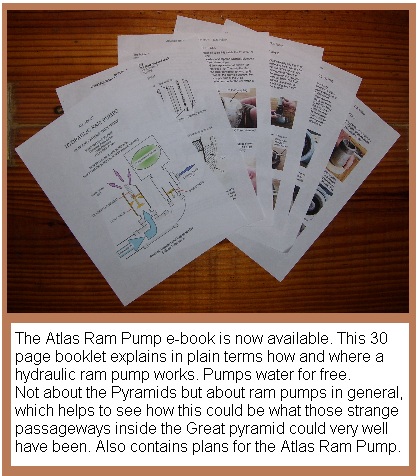 © 2013 Atlas Publications
The Great Pyramid of Giza.
© 2013 Atlas Publications
The Great Pyramid of Giza.
The Descending passage from the entrance to the 'Pit' or
'Unfinished' Subterranean Chamber.
Cross sectional drawing of the inner passages and
chambers of the Pyramid as known to date.
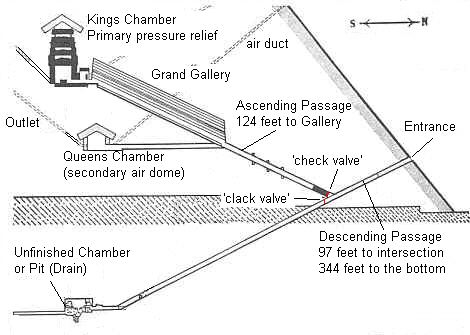
The Descending Passage
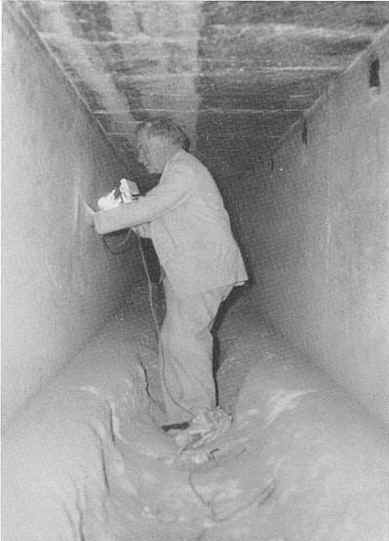 As you can see, the passage is very smooth, almost polished, in spite of its age. The first 130 feet are polished
limestone blocks, the rest, on down to the 'subterranean chambers', are polished limestone bedrock.
It angles down at 26 degrees. Note the floor, recently chiseled deeply, in order for people to walk erect
while exploring. The original dimensions were 3 ft. 6 in. wide by 3 ft. 11 in. high. Not a realistic size
to walk in, but it was built for water flow. That is why the walls are so smooth; less drag for moving water.
As you can see, the passage is very smooth, almost polished, in spite of its age. The first 130 feet are polished
limestone blocks, the rest, on down to the 'subterranean chambers', are polished limestone bedrock.
It angles down at 26 degrees. Note the floor, recently chiseled deeply, in order for people to walk erect
while exploring. The original dimensions were 3 ft. 6 in. wide by 3 ft. 11 in. high. Not a realistic size
to walk in, but it was built for water flow. That is why the walls are so smooth; less drag for moving water.
The original builders probably hired children to clean the passages of accumulated silt, or other
maintenence tasks that would need to be done periodically to keep the pump functioning, such as removing
debris or even replacing the valve blocks. Getting to the ascending chamber would be a much larger project,
but it could be done after jacking the check block up and draining the whole system. Maybe every 10 or 20 years!
The Intersection
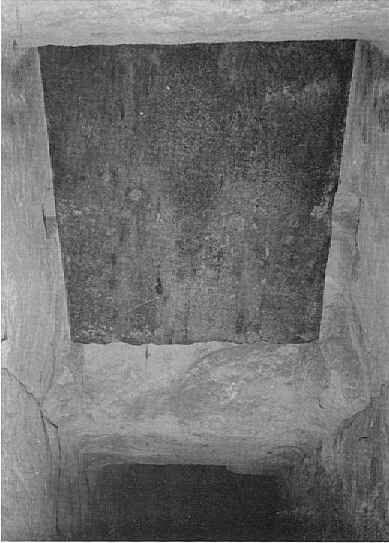 As we continue down the descending passage from the entrance, after about 97 feet, we come to where the
ascending passage intersects with it, in the ceiling. It is now blocked by 3 large granite blocks.
As we continue down the descending passage from the entrance, after about 97 feet, we come to where the
ascending passage intersects with it, in the ceiling. It is now blocked by 3 large granite blocks.
This we call the 'Intersection'. It is a very important part of the system, where the two 'valves'
were--the only moving parts of the whole ram pump system. They were surely taper-edged stone blocks, granite,
or something even harder. The tapered edge, of course, was for a seal when seated--like modern day engine valves.
Above (top of photo) was where the check valve block was. The upper (check) block sealed in place with
gravity and water pressure, and opened upward.
Below (bottom of photo) you see the edge of the descending
passage continuing down. This was where the clack valve block was.
We haven't found a good photo of this
part yet--but in this photo you can still see the remnants of tapering around the opening where the clack block
sealed. This clack block was balanced to pivot open, towards you, in this point of view.
Detail of the Clack Block Seat

Enlarged diagram of the 'Intersection'
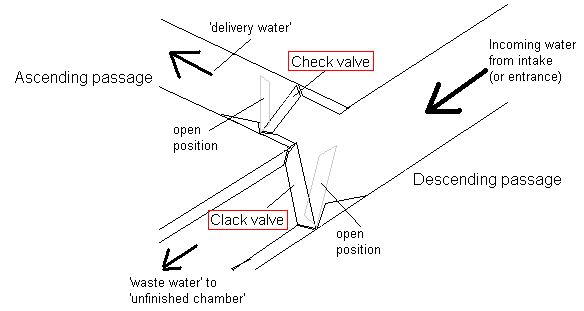
An explanation for the above drawing is probably in order. Water, rushing down the descending passage
from the entrance (or intake) and rushing past the 'clack valve block' would force the block to pivot to the
closed position. This would happen suddenly, and the result---that massive column of water, stopped suddenly
by the closing of this valve block, would create, for a moment, a very high pressure--this is called a
'water-hammer' in the plumbing trade. This column of water reacts like a battering ram. Instead of battering
the clack block, though, the check block, acting as a one-way valve, is right there-to relieve that surge of
high pressure water. The water surges, for a moment, through the check block, into the ascending passage.
When the surge is expended, the check block falls back to the closed position, sealing the water in the
ascending passage. The clack block, balanced to fall open, does so, allowing the water to surge past it,
starting the cycle all over again.
Stone slabs used as valves would last a LONG time--maybe centuries!
As long as the water source remained uniterrupted, and no debris entered the system to jam one of the valves,
this system would work.
Below the Intersection
Beyond the intersection, below the clack valve block, the passage continues, much as before, at the same
angle down, for about 277 feet, where it hits a horizontal section. This shorter horizontal section leads
to the subterranean chamber. This large chamber is a strange place, measuring 46 feet by 27 feet with a
height of about 11 feet. It is cut deep into the bedrock almost 600 feet directly below the apex of the
Pyramid, and 150 feet below the base of the Pyramid. It's ceiling is smooth and and the floor is cut in
several rough levels, making it look unfinished. It has also been referred to as the "upside down room".
In the center of this chamber on the east side is a square pit which is known as the "bottomless pit".
It is called the "bottomless pit" since at the time of its discovery, it was not known how deep it was.
Continuing from the subterranean chamber is a smaller passage (about 2 1/2 feet square) that runs horizontal
for about 53 feet and ends in a blank wall. Lots of debris has accumulated, but it is apparent that this
functioned as a drain, with many fissures in the rock, which probably let the 'waste' water (but clean!)
from the ram cycle into the surrounding water table.
Intro
Descending Passage
NEXT PAGE
Grand Gallery & Kings Chamber
Pyramid Pump
This site is a collaboative effort by:
Edward Weaver , amateur Egyptologist and avid Pyramidologist. Ed has studied these ancient civilizations for many years, as well as the idea of a hydraulic structure within the Giza Pyramid. Any comments or questions in these areas are welcomed.
Don Wilson.,
author of All About Hydraulic Ram Pumps e-book has been building, installing and consulting on ram pumps for almost 2 decades. His experiences revealed the functions of the inner chambers and passages of the Great Pyramid as a possible working Hydraulic Ram Water Pump. Any comments or questions in these areas. or on this web site, are welcomed.
Most of the photos in this site were taken from the out of print PYRAMIDOLOGY by Adam Rutherford, and SECRETS OF THE GREAT PYRAMID by Peter Tompkins; also some material from the Giza Pyramid Research site as well as other public domain sources. Much thanks and appreciation to these.

© 2013 Atlas Publications
© 2001 Edward Weaver

 © 2013 Atlas Publications
© 2013 Atlas Publications

 As you can see, the passage is very smooth, almost polished, in spite of its age. The first 130 feet are polished
limestone blocks, the rest, on down to the 'subterranean chambers', are polished limestone bedrock.
It angles down at 26 degrees. Note the floor, recently chiseled deeply, in order for people to walk erect
while exploring. The original dimensions were 3 ft. 6 in. wide by 3 ft. 11 in. high. Not a realistic size
to walk in, but it was built for water flow. That is why the walls are so smooth; less drag for moving water.
As you can see, the passage is very smooth, almost polished, in spite of its age. The first 130 feet are polished
limestone blocks, the rest, on down to the 'subterranean chambers', are polished limestone bedrock.
It angles down at 26 degrees. Note the floor, recently chiseled deeply, in order for people to walk erect
while exploring. The original dimensions were 3 ft. 6 in. wide by 3 ft. 11 in. high. Not a realistic size
to walk in, but it was built for water flow. That is why the walls are so smooth; less drag for moving water.
 As we continue down the descending passage from the entrance, after about 97 feet, we come to where the
ascending passage intersects with it, in the ceiling. It is now blocked by 3 large granite blocks.
As we continue down the descending passage from the entrance, after about 97 feet, we come to where the
ascending passage intersects with it, in the ceiling. It is now blocked by 3 large granite blocks.


